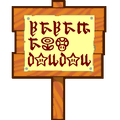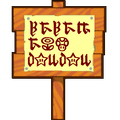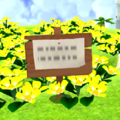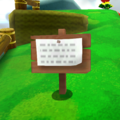User:Nintendo101/flowerpot: Difference between revisions
Nintendo101 (talk | contribs) (guidepost draft) |
Nintendo101 (talk | contribs) mNo edit summary Tag: Disambiguation links |
||
| Line 31: | Line 31: | ||
===''Paper Mario'' series=== | ===''Paper Mario'' series=== | ||
====''Paper Mario''==== | |||
called a "signboard" in the [[Close Call (badge)]] prediction. | |||
====''Paper Mario: The Thousand-Year Door''==== | ====''Paper Mario: The Thousand-Year Door''==== | ||
dunno | dunno | ||
| Line 41: | Line 44: | ||
Sign Model SM64.png|''[[Super Mario 64]]'' | Sign Model SM64.png|''[[Super Mario 64]]'' | ||
Board SM64.png|''Super Mario 64'' | Board SM64.png|''Super Mario 64'' | ||
Goomba Road.png|''[[Paper Mario]]'' | |||
SMS Asset Model Board.png|''[[Super Mario Sunshine]]'' | SMS Asset Model Board.png|''[[Super Mario Sunshine]]'' | ||
PMTTYD Sign.png|''[[Paper Mario: The Thousand-Year Door]]'' | PMTTYD Sign.png|''[[Paper Mario: The Thousand-Year Door]]'' | ||
| Line 48: | Line 52: | ||
SMG2 Screenshot Board.png|''[[Super Mario Galaxy 2]]'' | SMG2 Screenshot Board.png|''[[Super Mario Galaxy 2]]'' | ||
</gallery> | </gallery> | ||
==Names in other languages== | |||
{{foreign names | |||
|Jap=看板 | |||
|JapR=Kanban | |||
|JapM=Signboard | |||
}} | |||
==See also== | |||
*[[Arrow Sign]] | |||
*[[Hint Art]] | |||
*[[Rankings Board]] | |||
*[[Star Coin Sign]] | |||
*[[Stump]] | |||
*[[Tip Network]] | |||
*[[Wooden cutout]] | |||
==References== | ==References== | ||
<references/> | <references/> | ||
{{SM64}} | |||
{{PM}} | |||
{{Super Mario Sunshine}} | |||
{{PMTTYD}} | |||
{{SPM}} | |||
{{SMG}} | |||
{{SMG2}} | |||
{{SMO}} | |||
{{SMBW}} | |||
Revision as of 01:44, April 27, 2024
| flowerpot | |
|---|---|
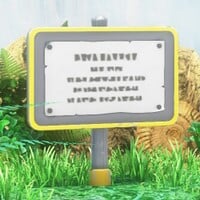 Screenshot from Super Mario Odyssey | |
| First appearance | Super Mario 64 (1996) |
| Latest appearance | Super Mario Bros. Wonder (2023) |
| Effect | Provides information when read. |
Travel Tips, also known as signs,[1][2][3] signboards,[4] or boards, are guideposts in the Super Mario franchise that debuted in Super Mario 64. In all appearances, a Travel Tip provides information on an available action or the current level when prompted. Travel Tips are either staked into the ground like posts, or attached to the side of walls. Staked Travel Tips often have a secondary interactive element.
The player is rarely obligated to read Travel Tips. They are there if needed. In Super Mario Galaxy and Super Mario Galaxy 2, there are a few boards that are conscious, speaking characters.
History
Super Mario series
Super Mario 64 / Super Mario 64 DS
A posted board that contains information on actions, scenarios, and locations. Signs can be ground-pounded into the ground. There are variants found hanging on walls.
Super Mario Sunshine
Posted signs that contain information on actions.
Super Mario Galaxy
Posted signs that contain information on actions. Most Boards are inanimate objects that give Mario insight on his surroundings or actions when read. However, a few Boards are speaking characters that give specific instructions on how to use objects or power-ups that change how Mario is controlled.
Super Mario Galaxy 2
Posted signs that contain information on actions. One of them is a speaking character.
Super Mario Odyssey
Signs that contain information on actions. Some are fastened to walls, while others are staked into the ground. Like Arrow Signs, staked Travel Tips spin when struck by Cappy.
Super Mario Bros. Wonder
appear on the world map
Paper Mario series
Paper Mario
called a "signboard" in the Close Call (badge) prediction.
Paper Mario: The Thousand-Year Door
dunno
Super Paper Mario
dunno
Gallery
Names in other languages
| Language | Name | Meaning |
|---|---|---|
| Japanese | 看板 Kanban |
Signboard |
See also
References
- ^ "To read a sign or talk to someone, press the B Button. (You can talk to some people just by stopping right in front of them.) If a message is long, press the A or B Button to continue reading. Often, important hints are written on the signs." – Nintendo of America (1996). Super Mario 64 Instruction Booklet (PDF). Redmond: Nintendo of America. Page 8.
- ^ Nintendo of America (2005). Super Mario 64 DS Instruction Booklet. Redmond: Nintendo of America. Page 13.
- ^ "While standing in front of certain characters or signs, you can press
 to speak or read." – Nintendo of America (2007). Super Mario Galaxy Instruction Booklet (PDF). Redmond: Nintendo of America. Page 13.
to speak or read." – Nintendo of America (2007). Super Mario Galaxy Instruction Booklet (PDF). Redmond: Nintendo of America. Page 13.
- ^ "Stand in front of certain characters and press the A Button to talk to them, or stand in front of signboards and press the A Button to read them." – Nintendo of Europe (2010). Super Mario Galaxy 2 Instruction Booklet (PDF). Großostheim: Nintendo of Europe. Page 18.




